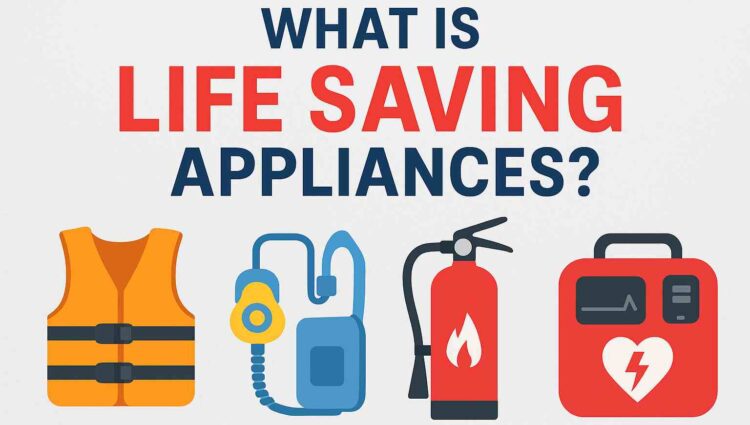Life is unpredictable, and emergencies can occur anywhere—on ships, in the air, at workplaces, or even at home. In these critical moments, life saving appliances (LSAs) play a vital role in protecting people and ensuring survival.
These are not just ordinary safety tools but regulated, certified equipment designed to save lives. Whether it’s a life jacket on a ship, an automated external defibrillator (AED) in a mall, or a smoke detector at home, life saving appliances are the last line of defense in emergencies.
A common pain point: Many people don’t know which appliances count as LSAs and often confuse them with general safety gear. This lack of awareness leads to poor preparedness during life-threatening situations.
Understanding Life Saving Appliances (LSA)
Life Saving Appliances are specialized devices and systems intended to protect, rescue, and sustain individuals during emergencies.
According to the International Maritime Organization (IMO) and Safety of Life at Sea (SOLAS) convention, LSAs are mandatory on ships to ensure passengers and crew survive accidents. Similarly, in aviation, Civil Aviation Authorities (CAA) mandate life vests, oxygen masks, and rafts. In healthcare, devices like ventilators and AEDs fall under life-saving categories.
Entities connected to LSAs include:
-
SOLAS (Safety of Life at Sea) – governs maritime LSAs.
-
IMO (International Maritime Organization) – sets international safety rules.
-
OSHA (Occupational Safety and Health Administration) – enforces workplace safety in the U.S.
-
ISO standards – certify equipment like helmets, fire extinguishers, and medical devices.
Types of Life Saving Appliances
1. Maritime Life Saving Appliances (as per SOLAS regulations)
Ships and boats are legally required to carry LSAs to protect passengers and crew during emergencies at sea. These include:
-
Life jackets – provide buoyancy and keep individuals afloat.
-
Lifeboats & rescue boats – used for evacuation.
-
Life rafts – inflatable, easy to deploy in emergencies.
-
Buoyant apparatus – floating devices for multiple survivors.
-
Immersion suits & thermal protective aids – protect from hypothermia.
-
Distress signals – flares, EPIRBs (Emergency Position Indicating Radio Beacons), and SARTs (Search and Rescue Transponders).
Pain point: Passengers often don’t know how to properly wear life jackets or use flares, making safety drills crucial.
2. Fire & Emergency Safety Appliances
-
Fire extinguishers (water, foam, CO2, dry chemical).
-
Fire blankets for smothering small flames.
-
Smoke detectors & alarms to alert occupants.
-
Firefighter breathing apparatus (SCBA) for safe rescue operations.
Pain point: Many workplaces have extinguishers installed but never train staff on how to use them effectively.
3. Aviation Life Saving Appliances
Aviation authorities require LSAs on all commercial aircraft. These include:
-
Oxygen masks – drop automatically during cabin depressurization.
-
Life vests – kept under seats.
-
Emergency slides & rafts – enable quick evacuation.
-
Locator beacons – help rescuers find aircraft after accidents.
Pain point: Passengers often ignore pre-flight safety briefings, reducing effectiveness of these LSAs.
4. Healthcare & Medical Life Saving Appliances
In the medical field, LSAs save millions of lives every year:
-
Automated External Defibrillators (AEDs) – restart a heart during sudden cardiac arrest.
-
Ventilators – support breathing for critical patients.
-
Oxygen kits – used in emergencies and disaster zones.
-
First aid kits – for immediate treatment of injuries.
Entities: American Heart Association (AHA) recommends AED placement in public spaces; WHO highlights ventilators as life-critical equipment.
5. Home & Workplace Safety Appliances
-
Smoke & carbon monoxide detectors – prevent fatalities from fire or gas leaks.
-
Emergency lighting systems – guide people during blackouts or fires.
-
Panic alarms – used in banks, schools, or homes for quick emergency alerts.
-
Safety helmets & harnesses – crucial in construction and industrial workplaces.
Pain point: Many households lack basic smoke detectors, leading to preventable fire-related deaths.
Regulatory Standards for Life Saving Appliances
-
SOLAS Convention (IMO) – mandates LSAs on ships.
-
ISO standards – certify equipment for quality and safety.
-
OSHA regulations – workplace safety in industries.
-
Civil Aviation Authority (CAA) – sets aviation safety rules.
Failure to comply can result in fines, shutdowns, or loss of certification.
Why Life Saving Appliances Are Important
-
Protect lives during disasters – survival during shipwrecks, fires, or medical emergencies.
-
Ensure compliance – businesses meet safety regulations and avoid penalties.
-
Increase public trust – passengers and customers feel safer when LSAs are visible.
-
Reduce loss of workforce – critical for industries like construction, mining, and oil rigs.
Pain point: Many organizations only invest in LSAs for compliance, not realizing they directly affect survival rates.
How to Choose the Right Life Saving Appliances
-
Environment-based selection – ship, aircraft, workplace, or home.
-
Check certifications – SOLAS-approved, ISO-certified, CE marking.
-
Quality over cost – avoid cheap, uncertified appliances that fail in emergencies.
Example: A counterfeit life jacket may look real but won’t keep a person afloat in rough seas.
Maintenance & Inspection of Life Saving Appliances
-
Conduct monthly and annual inspections.
-
Train staff/employees on proper use.
-
Replace expired equipment (flares, extinguishers, medical supplies).
-
Follow Coast Guard and OSHA inspection requirements.
Pain point: Many appliances fail during real emergencies because they were not maintained properly.
Common Mistakes & Misconceptions
-
Confusing general safety gear with certified LSAs.
-
Storing life jackets under heavy objects (making them hard to access).
-
Ignoring expiry dates of fire extinguishers and first aid kits.
-
Not conducting safety drills for staff or passengers.
Future of Life Saving Appliances
-
Smart LSAs – GPS-enabled life jackets, IoT-connected smoke detectors.
-
AI-powered emergency alerts – predictive fire and flood detection.
-
Lightweight materials – making appliances more durable and user-friendly.
Entities: Companies like Honeywell, 3M, and Dräger are leading in innovation of smart LSAs.
FAQs
Q1: What is considered a life saving appliance on a ship?
Life jackets, lifeboats, life rafts, immersion suits, and distress signals are mandatory.
Q2: What are the mandatory LSAs under SOLAS?
Ships must carry life jackets, rafts, boats, immersion suits, EPIRBs, and SARTs.
Q3: What life saving appliances should every home have?
At minimum: smoke detectors, fire extinguishers, and a first aid kit.
Q4: How often should LSAs be inspected?
Monthly checks and annual inspections are recommended by regulatory authorities.
Q5: Can expired LSAs still be used?
No. Expired equipment like flares or fire extinguishers must be replaced immediately.
Conclusion
Life saving appliances are essential tools that bridge the gap between danger and survival. From the seas to the skies, workplaces to homes, LSAs ensure safety during emergencies.
The key is not only owning these appliances but also ensuring they are certified, regularly maintained, and correctly used. Investing in quality LSAs is not just compliance—it’s an investment in human lives.



Leave Comment